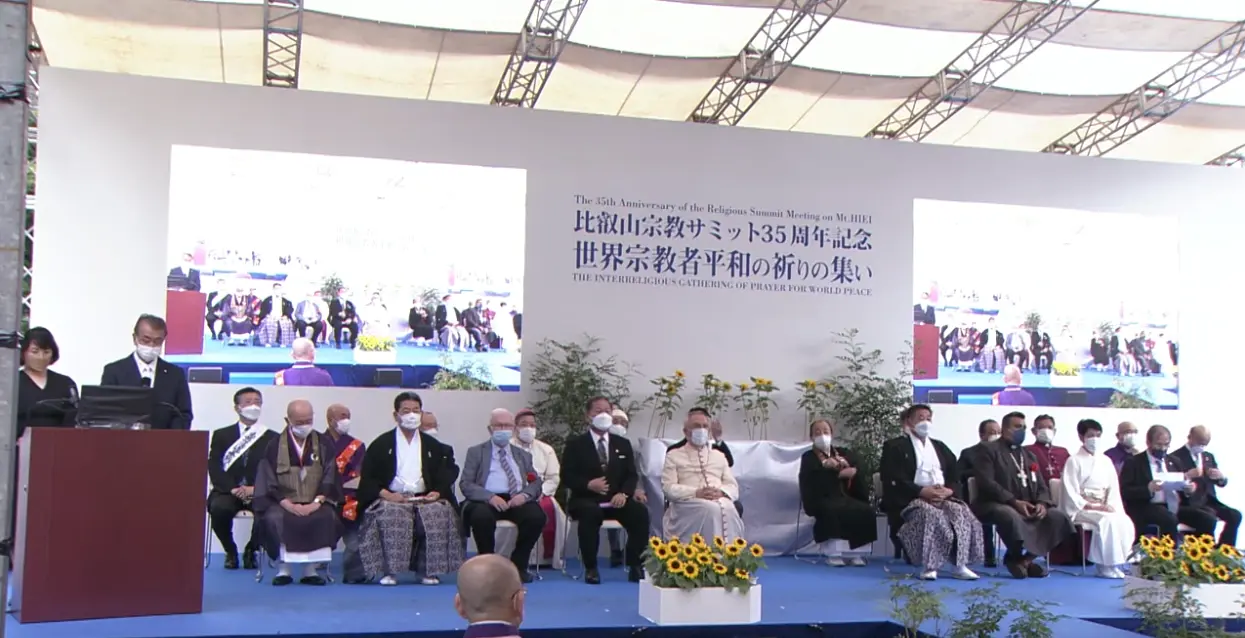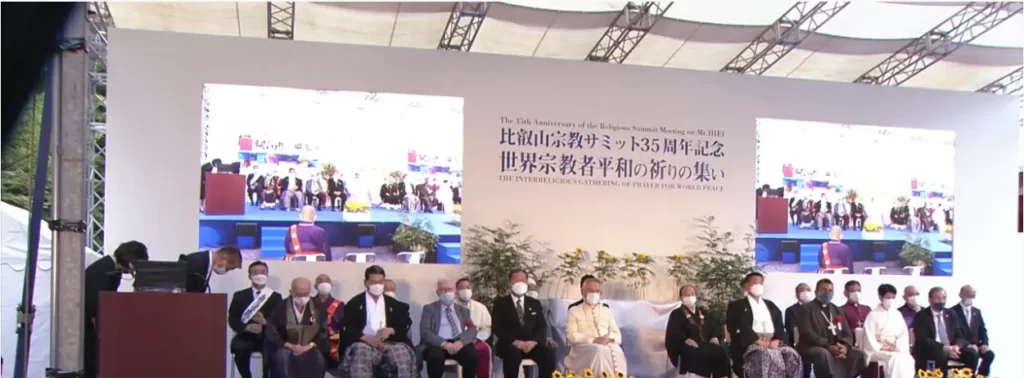On 4th AUGUST, 2022, about 2,000 people, including 24 delegates from 18 countries of Buddhism, Shintoism, Christianity, Islam, Judaism, Hinduism and Zoroastrianism came together in Japan at an inter-faith “Interreligious Gathering of Prayer for World Peace”. The event marked the 35th anniversary of the first ‘Religious Summit’ held on Mount Hiei in 1987. Moderator of Religions for Peace Asia, Emeritus Professor Desmond Cahill OAM delivered a talk on Megacities and Climate Change – The Role of Religious Leaders.
MEGA-CITIES AND CLIMATE CHANGE: The ROLE of RELIGIOUS LEADERS
May I begin by thanking you for honouring me with this invitation to speak. I bring to this Religious Summit the greetings of Religions for Peace Asia and its 22 member nations, representing 52 per cent of the world’s people. I also bring the greetings of Australia to the Japanese people, still suffering from the assassination of your former Prime Minister. Shinzo Abe was close to Australia and we valued his friendship.
We stand on Mt. Hiei, the holy mountain of Japanese Buddhism. Most religions have sacred mountains such as Mt. Sinai, Mt Putuo, Mt Kailash and Uluru in my own country for our First Peoples. Our world, the whole universe, is a gift, a blessing and a responsibility that we have not only for the natural environment but also for the built environment.
If most religions have their holy mountains, all faith traditions have their holy cities, Medina and Mecca for Muslims, Jerusalem for Jews and Christians, Rome for Catholic Christians, Lhasa for Tibetan Buddhism, Amritsar for the Sikhs and Varanasi which has a central place in pilgrimage, death and mourning in the Hindu world. And now we have mega-cities and megalopolises which are my focus today. In 2007, the world’s urban population surpassed those living in rural areas, and by now 55 per cent are living in cities even though they occupy only 3 per cent of the total land mass. The United Nations estimates that by 2050 68 per cent of the world’s population will be living in cities. Amongst the UN’s list of mega-cities with more than ten million residents, only China and Japan have two cities in the top ten, Shanghai and Beijing, Tokyo and Osaka. By 2030, there will be 29 in the Asia-Pacific region, and 19 in the rest of the world.
Mega-cities are hubs for business and economic activity as centres for innovation and productivity but religion is also a living part of every city, shaping and being shaped by the urban context and in the use of public sacred spaces and sacred rituals for life’s more important moments to mourn, celebrate, remember, reflect and to help others, especially the poor, the sick and the homeless. Cities are dotted, often close to their centres, with sacred places of worship: temples, churches, mosques, synagogues and gurdwaras.
Mega-cities, however, are being heavily impacted by climate adversity, including natural disasters, drought, food insecurity, extreme temperatures. They consume food and energy; they impact on air quality with chemical pollutants, trace gases and aerosols with carbon dioxide, nitrogen oxides, ammonia, sulphur dioxide and black and organic carbon. And they produce waste, mountains and mountains of waste in solid, liquid and gaseous form.
As religious leaders, we must accept the science of climate change in all its complexities. Our mega-cities are in danger, grave danger if climate change is not addressed, motivated by the consistent religious teaching by all faiths that we must respect and take care of the environment created by the Lord God, the Lord Buddha. We must be innovative and educate our communities and the wider community of the necessity to address climate change in its many facets.
We could begin with our places of worship and religious buildings by transforming their heating, ventilation and air-conditioning systems through proper insulation, and sealing and vapour barriers, sealing cracks and planting trees and shrubs in urban gardens, internal green ferneries and rooftop gardens in our mega-cities. Sacred people, sacred plants, sacred places, drawing on clean renewable sources of energy including solar panels and wind turbines.
Beyond this, we religious leaders have a wider responsibility as religious leaders to advocate for change for our city contexts:
⟴ Know our mega-cities’ weaknesses and vulnerabilities
⟴ Reduce greenhouse gas emissions and be aware of our city’s carbon footprints
⟴ Plant more trees and shrubs in our urban context, not least with roof-top gardens
⟴ Use energy efficiently
⟴ Go beyond petrol and diesel-driven cars, buses and trucks
⟴ Build sea walls, surge barriers and flood-resistant buildings
⟴ Encourage land recovery and restoration
⟴ Move communities from low-lying areas
⟴ Recycle disused urban spaces
⟴ Reduce and recycle waste
⟴ Ban plastic
Waste is an important issue. We must move from a straight-line or linear economy of producing, using and discarding to a circular economy governed by the philosophy of reduction, re-use and recycling of waste. Religion and religious leaders are an untapped resource in protecting cities, especially in creating a moral and religious framework for protecting the earth and forging a new future in our mega-cities.
Coastal cities are especially in danger not just from climate change but from land subsidence and accelerated urbanization. The cities said to be most at risk are: Jakarta, Lagos, Houston, Dhaka, Venice, Bangkok, Rotterdam, Miami and Alexandria in Egypt. But there are others, including Osaka. They are at risk from sea level rises, storm surges and high tides. For all cities, water management must become a priority. Not only are our cities to become green cities, they must also become blue cities where water is managed effectively. A blue city is where there is an integrated management of water able to address the risks of too much, too little and too polluted water.
Today we live in a world of greater risk, limited controllability, and uncertain predictability. Global mega-cities are the hubs or nodes in the process of combatting climate change. His All-Holiness Bartholomew, Ecumenical Patriarch of Constantinople, who is known as the Green Patriarch, has said, “We use the Greek work kairos to describe a critical moment in time, often a specific historical period with lasting repercussions and eternal significance. For humankind and the planet as a whole, now is the kairos: the decisive time in our relationship with all of God’s creation, when we must respond in an opportune manner to protect life on earth from the worst consequences of human recklessness. May God grant us the wisdom to act promptly”.
Download this Paper
Emeritus Professor Desmond Cahill, is Professor of Intercultural Studies at RMIT University in Melbourne. He is currently President of Religions for Peace Australia (www.religionsforpeaceaustralia.org.au) and had worked for more than two decades in cementing interreligious relations in Australia and across Asia. Educated in Melbourne and Rome, he worked pastorally for the Catholic Church during the 1970s before embarking on an academic career in ethnic and religious diversity and cross-cultural communication. Prof. Cahill was elected Moderator of the Asian Conference of Religions for Peace on October 22, 2021.

© Desmond P Cahill, 2022
Tags: Interreligious Gathering of Prayer for World Peace, Megacities and Climate Change, Role of Religious Leaders in Climate Change



